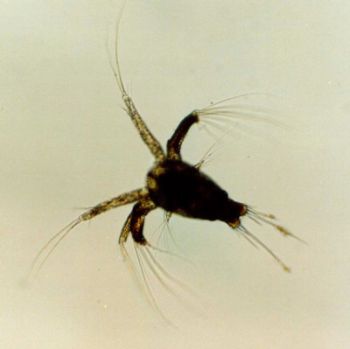
The California spiny lobster Panulirus interruptus
Photo by Ed Bierman, via Flikr, Creative Commons Attribution
| Crustacea | ||
| Arthropoda | Crustacea - 1 |
| Metazoa | Metazoa | ||||
| Glossary |
|
Protostomia
├─Arthropoda
│ ├─Trilobita
│ └─Pancrustacea
│ ├─Crustacea
│ │ ├?─Pentastomida
│ │ └─┬─Remipedia
│ │ └─┬─Cephalocarida
│ │ └─┬─Malacostraca
│ │ └─┬─Maxillopoda
│ │ └─Branchiopoda
│ └─Insecta
└─Lophotrochozoa
├─Mollusca
└─Annelida
|
Contents
Introduction |
 The California spiny lobster Panulirus interruptus Photo by Ed Bierman, via Flikr, Creative Commons Attribution |
With around 35,000 known species (and many more doubtless not yet discovered) the Crustacea are a diverse group. They are so incredibly abundant in marine and freshwater habitats are they that they have been called the insects of the water. A majority of zooplankton are Crustacea - either larvae or tiny adults. A few Crustacea (slaters or sow bugs) even live on land, usually under old logs and leaf litter. The majority of crustaceans are marine and are herbivores, although there are also many species which are carnivores, scavengers, or filter-feeders
The Crustacea are a very ancient group. They first evolved in the earliest Cambrian period, as part of the great evolutionary radiation of that time. By the Jurassic Crustaceans looked pretty much like they do today.Shrimps and lobsters from the famous Solnhofen limestone are hardly distinguishable from modern forms
 Crustacea are characterized by two pairs of antennae, three pairs of mouthparts, and a special type of larvae called the nauplius (see photo at right) Most crustaceans have jointed appendages which serve as either walking or swimming legs, and some of which have been modified in some way to serve a special function, such as the claws of lobsters and crabs. The number of body segments varies widely among the different groups. They generally also have a carapace and compound eyes .
Crustacea are characterized by two pairs of antennae, three pairs of mouthparts, and a special type of larvae called the nauplius (see photo at right) Most crustaceans have jointed appendages which serve as either walking or swimming legs, and some of which have been modified in some way to serve a special function, such as the claws of lobsters and crabs. The number of body segments varies widely among the different groups. They generally also have a carapace and compound eyes .
The following is a list of classes of this diverse group
Remipedia
Cephalocarida
Branchiopoda
Ostracoda
Mystacocarida
Copepoda
Branchiura
Cirripedia (Barnacles)
Tantulocarida
Malacostraca
Page MAK020505 revised MAK120515 Creative Commons Attribution